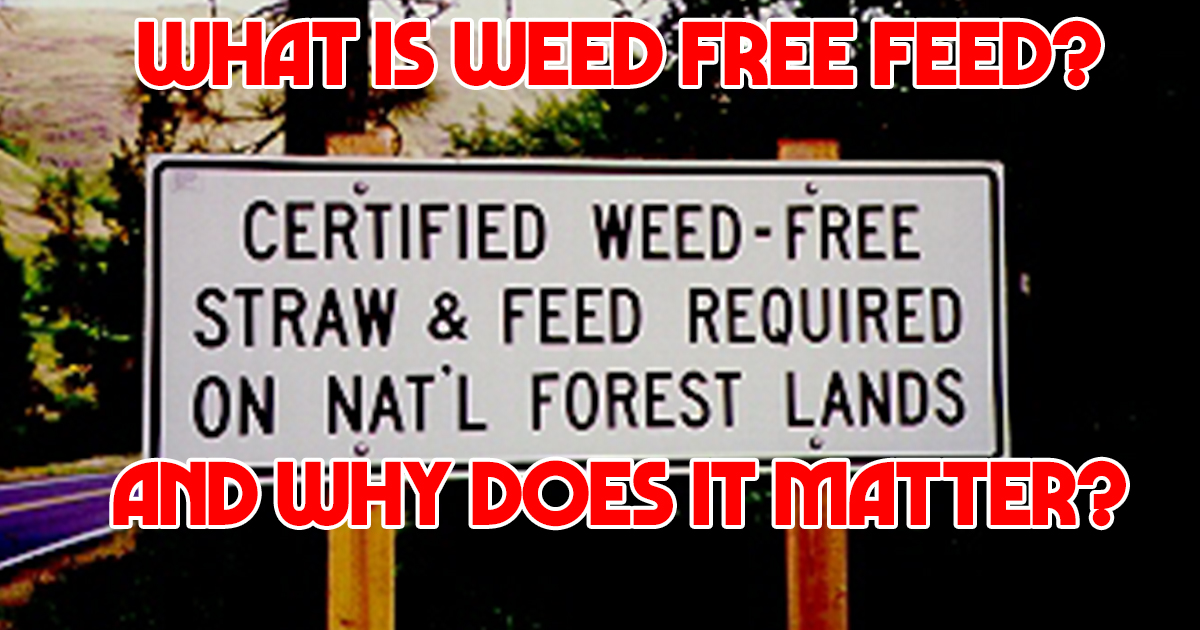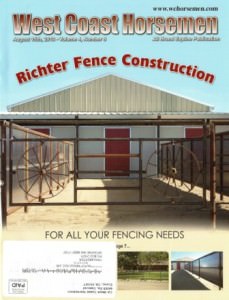What is Weed Free Feed – and Why Does it Matter?
As published in the August 2013, issue of West Coast Horsemen Magazine
You’ve most likely heard the terms “weed free feed” or “certified weed free forage”. Whether this special feed for horses and mules is required or simply requested where you ride, it’s a good idea to have a basic level of knowledge about what these feeds are and more importantly which feeds fulfill the requirements.
The problem of invasive species is real and has been described as the largest conservation concern of the 21st century. Invasive species are now found in all 50 states, and published reports estimate the negative economic impact to be as much as $138 billion annually. To combat this threat, federal and state agencies across the US have responded aggressively, and with a broad brush that has affected recreational stock users in a profound way. Although studies and academic papers have been published that show stock use poses very little probability of spreading noxious weeds, laws have been enacted that we must comply with lest we find ourselves receiving a substantial ticket or worse. Unlike a parking ticket the penalties for violating these rules can be severe and include fines up to $10,000 or 6 months of jail time.
Rather than risk having an enjoyable camping trip cut short by a hefty fine for not following the rules it’s a good idea to prevent such issues by researching the requirements of the area you’re planning on riding and then deciding how to comply. Most National Forests, National Parks, and National Grasslands on the west coast require some type of weed free certification and many BLM agencies while not currently requiring the public to use weed free feed are using this type of feed for their own projects. Check with the agency’s website for their rules for a specific area.
There are currently several types of weed free feed that meet the requirements that we must adhere to. The North American Weed Management Association (NAWMA) has established standards for forage, or unprocessed hay, as well as processed feeds such as cubes and pellets.
Certified noxious weed seed free hay bales are distinguished by a bale tag or unique color twine that identifies a hay field that has been inspected by the state agriculture department and found free of noxious weeds.
The major advantage of unprocessed hay, from a dietary standpoint, is the fiber length of the hay stems. Greater fiber length takes stock longer to chew and digest. This keeps your animal’s digestive systems full and working longer. Fiber length also helps to keep a horse warmer in cold weather. The major disadvantage of baled or unprocessed hay is the weight and bulk of the hay bales when packing s into distant camps. Many people find heavy hay bales cumbersome to pack and carry.
Certified weed free hay cubes and pellets are minimally processed feeds and are essentially hay that has been chopped and ground and heat-pressure treated into a cube or pellet. Bags of certified Noxious Weed Free Forage Cubes/Pellets will be labeled with a certification tag stating compliance with North American Weed Free Forage Certification Program. Compared to a certified weed free hay bale, pellets and cubes create less mess and waste. In addition, the packaging of a processed product makes it easier to pack and transport. Less waste and increased digestibility means that a fifty pound bag of pellets could last as long as a sixty or seventy pound hay bale.
Commercially processed feed pellets or steamed, rolled grains are processed by finely grinding the ingredients, heat treating, and then compressing into pellets and do not need to be certified. These complete feeds (usually in large or small pellet form) in which ground hay is balanced with grains for energy, vitamins, and minerals are designed to replace 100% of the hay or pasture diet. Nutritionally speaking, the processed feeds have a guaranteed nutrient content. Fiber, energy, protein, vitamins, and minerals sources have all been balanced by a nutritionist to provide a complete feed. Therefore, you shouldn’t need to pack additional supplements.
Of course cubes and pellets have their disadvantages. First, your horses will drink considerably more water when fed pellets and cubes due to the reduced water content of the products. Be sure to provide plenty of fresh, clean water at all times to reduce the chance of colic. Also, there is a slightly increased chance of choking on pellets and cubes, especially if you have an enthusiastic eater. You can decrease the incidence of choke and provide extra water to your horse by soaking the pellets or cubes for several minutes before you feed. The second disadvantage to pellets and cubes is how quickly your animals will eat them. Most stock animals will consume pellets or cubes quickly, leaving your horse bored, and perhaps looking for mischief.
The preference is yours for which weed free option (unprocessed forage, cubed hay, or commercially processed feed) to use during your next trip into a regulated area. Unprocessed feeds are more similar to your horse’s normal feed but may be more difficult to find. Commercially processed feeds are readily available but don’t provide the roughage that the equine gut was designed to digest. Many experienced packers will take and use all three according to their personal preferences. Most commonly offering some hay and supplementing with cubed or pelletized feeds to round out the diet.
Regardless of which type of feeds you decide to use, make sure that any tags or certification certificates stay with the feed in case a ranger or land manager wants to verify the certification. Also, if you’re changing your horse’s diet begin gradually. Start changing over to the new feed a few days in advance so your horse can get used to the new feed and reduce the chance of colic.
Your task is to decide which method of feeding certified weed free feed is best for you by weighing the convenience of a packaged product to the fiber length of the hay bale. Whichever choices you make, have fun enjoying the trails from the back of your horse.
As always for more information on riding and camping areas throughout the west coast as well and trail riding Tips visit www.TrailMeister.com



